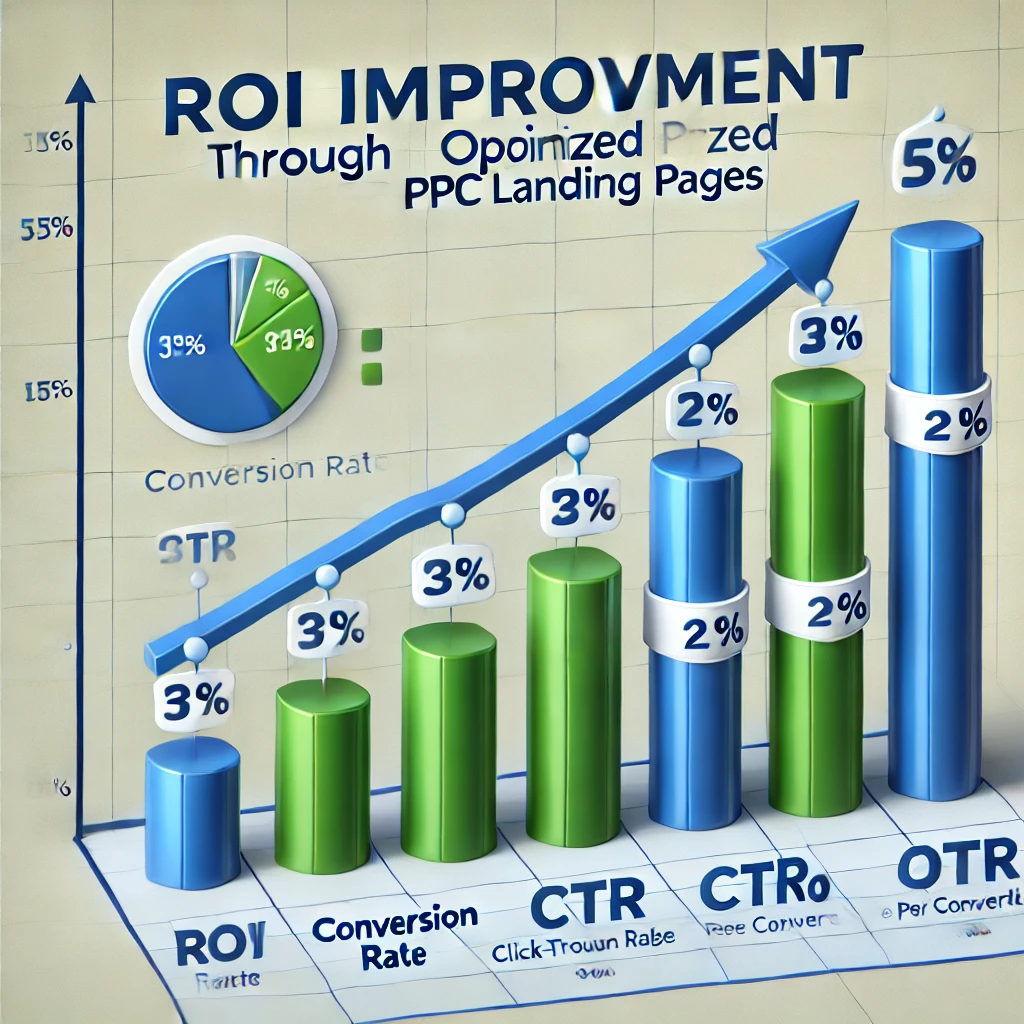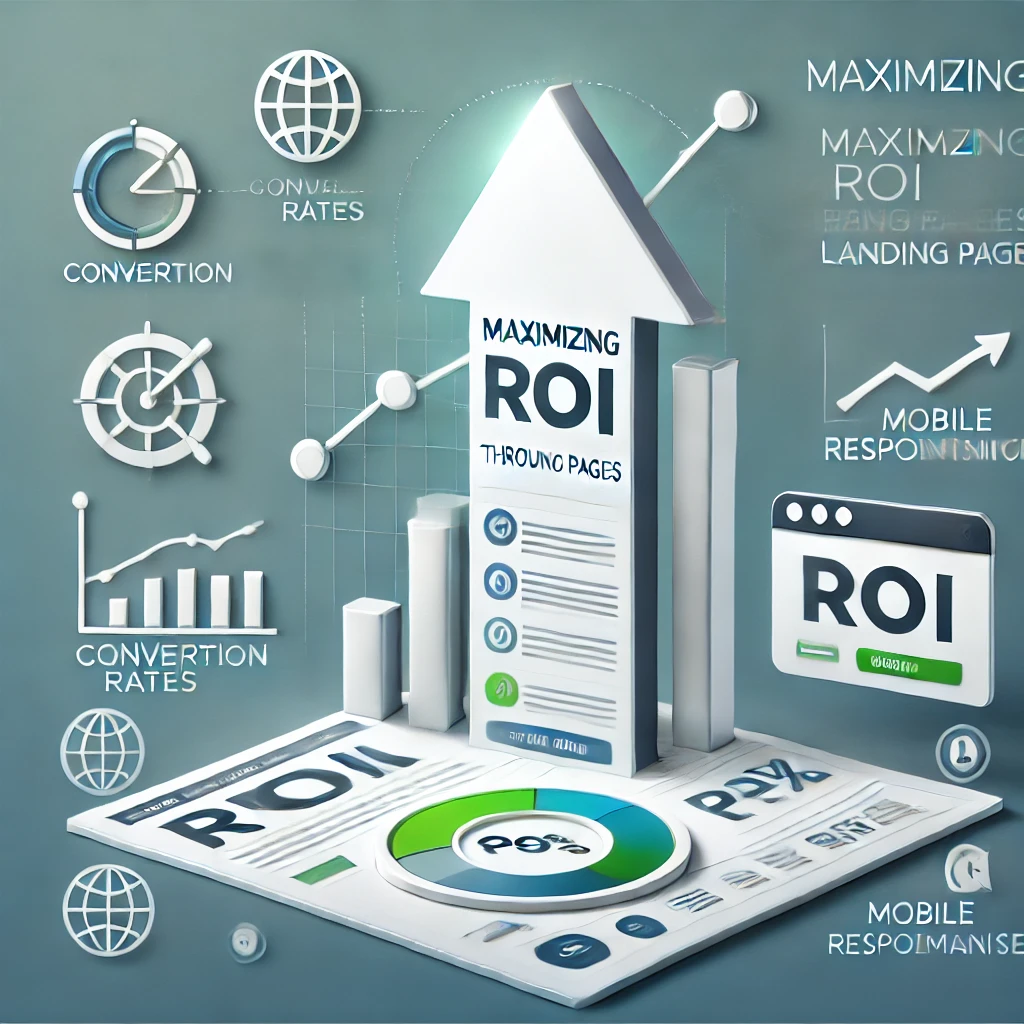Introduction
In the world of digital marketing, Pay-Per-Click (PPC) advertising is a powerful strategy that helps businesses gain visibility, attract leads, and drive conversions. However, even the most well-optimized PPC campaigns can fall flat without one crucial element — an effective landing page. A PPC landing page is the first touchpoint your potential customer has after clicking on your ad, and it plays a key role in determining the return on investment (ROI) of your PPC campaign.
This guide will explore the importance of a well-designed PPC landing page, how it directly impacts your ROI, and provide actionable tips to ensure your landing page is optimized for success.
1. Understanding ROI in PPC Campaigns
What is ROI?
ROI, or Return on Investment, is a key performance indicator that measures the profitability of an investment. In the context of PPC advertising, it reflects the revenue generated from your ads compared to the cost of running those ads. Calculating ROI is straightforward:
ROI=(Revenue from Ads−Ad Spend)Ad Spend×100\text{ROI} = \frac{(\text{Revenue from Ads} – \text{Ad Spend})}{\text{Ad Spend}} \times 100ROI=Ad Spend(Revenue from Ads−Ad Spend)×100
For instance, if you spend $1,000 on a PPC campaign and generate $3,000 in revenue, your ROI is 200%. A higher ROI indicates that your PPC campaign is delivering value and helping your business grow profitably.
2. Why PPC Landing Pages Matter for ROI
The Role of PPC Landing Pages
The landing page is the final step in your PPC funnel. While the ad captures the visitor’s attention, the landing page is responsible for converting that attention into action, whether it’s filling out a form, making a purchase, or subscribing to a service. Without an optimized landing page, you risk losing potential conversions, thus negatively impacting your ROI.
Key reasons why landing pages matter for ROI include:
- Conversion Focus: Unlike a general webpage, a landing page is designed for a specific goal, making it easier to convert visitors.
- Relevance: The more relevant your landing page is to the ad, the more likely it will result in conversions, improving your ROI.
- First Impressions: Your landing page is the first thing visitors see after clicking your ad. A well-designed page can instill trust, while a poorly constructed page can turn people away.
3. Essential Elements of a High-ROI PPC Landing Page
To maximize your ROI, your landing page needs to be strategically designed. Let’s dive into the essential components that make a landing page highly effective.
A. Clear and Compelling Headline
The headline is the first thing users will see when they land on your page. It should be concise, directly related to your PPC ad, and grab attention immediately. For instance, if your ad promotes a 50% discount on a product, your landing page headline should highlight that offer to maintain relevance.
Tip: Use actionable language in your headlines like “Get 50% Off Now!” or “Boost Your Sales Today with Our Services.”
B. Relevant and Engaging Content
The content of your landing page must be focused and concise. Provide information that aligns with your ad and is valuable to the visitor. Avoid overwhelming visitors with too much text, and instead focus on the benefits of your product or service.
Tip: Use bullet points and short paragraphs to make the content easily scannable. Highlight the key benefits and solutions you offer.
C. Strong Call-to-Action (CTA)
A compelling CTA is crucial for driving conversions. Your CTA should be action-oriented and clearly visible. Whether it’s “Buy Now,” “Get a Free Quote,” or “Start Your Free Trial,” make sure the visitor knows exactly what to do next.
Tip: Place your CTA button in a prominent location, above the fold, and ensure it contrasts with the rest of the page to stand out.
D. Visual Appeal
A visually appealing landing page increases engagement and keeps visitors interested. High-quality images, relevant graphics, and a clean, organized layout can enhance user experience and drive higher conversions.
Tip: Use visuals that complement your message, such as product images, customer testimonials, or explainer videos.
E. Fast Loading Speed
Page loading speed is critical. If your landing page takes too long to load, visitors will likely leave before they even have a chance to convert. Google’s research shows that as page load time increases from 1 to 3 seconds, the probability of bounce increases by 32%.
Tip: Optimize your images and use a reliable web hosting service to ensure your page loads quickly.
4. Optimizing PPC Landing Pages for Better ROI

Now that you know the essential elements of a great PPC landing page, let’s explore some optimization strategies to boost your ROI.
A. Match Ad Copy to Landing Page Content
Consistency between your PPC ad copy and landing page content is critical for conversions. The visitor clicked on your ad with a specific expectation, and your landing page should fulfill that expectation.
Example: If your PPC ad promises “Free Shipping,” make sure your landing page prominently mentions that offer.
B. Use A/B Testing
A/B testing allows you to compare two versions of your landing page to see which one performs better. You can test different headlines, images, CTAs, and even color schemes to identify which combination yields the highest conversion rate.
Tip: Test one element at a time for more accurate results, and use data-driven insights to make informed decisions.
C. Leverage Social Proof
People are more likely to convert when they see others have had positive experiences with your product or service. Including customer reviews, testimonials, and trust badges (like secure payment icons) can build credibility and boost conversions.
Tip: Display star ratings, customer success stories, or case studies to establish trust and influence visitor decisions.
D. Create Mobile-Friendly Landing Pages
With the rise of mobile users, ensuring your landing page is mobile-friendly is essential. A responsive landing page adapts to different screen sizes and maintains a seamless user experience across devices.
Tip: Use responsive design templates, reduce load times, and ensure your CTA is easy to click on mobile devices.
5. Common Mistakes to Avoid

To optimize your PPC landing page and improve your ROI, it’s important to avoid the following common mistakes:
- Cluttered Layout: Overloading your landing page with too much information can overwhelm visitors and lead to higher bounce rates.
- Weak CTA: A vague or hidden CTA can confuse visitors and reduce conversions. Ensure it’s clear and action-oriented.
- Ignoring Analytics: Always track key metrics like conversion rates, bounce rates, and page load times. Use analytics to identify areas of improvement.
- Not Testing: Without A/B testing, you might miss opportunities to enhance your landing page’s effectiveness.
6. How an Optimized PPC Landing Page Impacts ROI
A well-optimized landing page enhances your ROI by increasing the likelihood of conversions. Here’s how:
- Higher Conversion Rates: The more visitors that complete your desired action (like signing up or purchasing), the better your return on ad spend.
- Lower Cost Per Conversion: By improving the relevancy and performance of your landing page, you can lower the cost per conversion, meaning you spend less for each successful action.
- Better Quality Scores: Google considers landing page experience when determining your ad’s Quality Score. A high-quality score can reduce your cost-per-click (CPC) and increase your ad’s position.
Conclusion
An effective PPC landing page is essential for maximizing your ROI. By understanding the key elements of a high-performing landing page and implementing optimization strategies, you can enhance your PPC campaigns and generate better returns. From compelling headlines and clear CTAs to mobile responsiveness and A/B testing, every aspect of your landing page contributes to its overall success. Keep refining your landing pages, track performance, and continuously optimize for the best results.
By investing time and effort into creating and refining your PPC landing page, you’ll see a direct impact on the success of your campaigns — and most importantly, your ROI.
